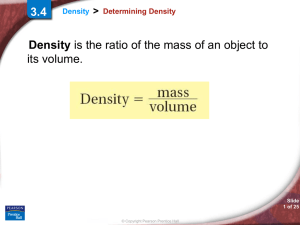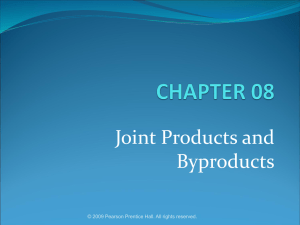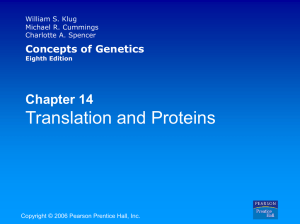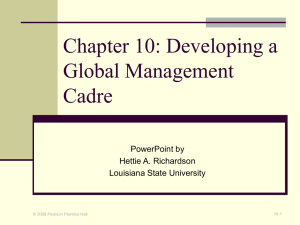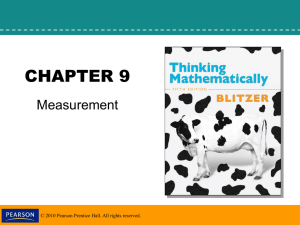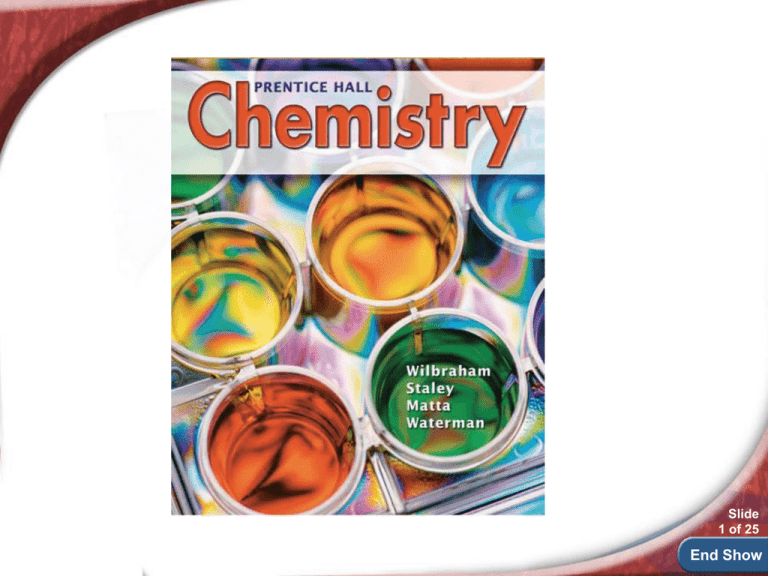
Slide
1 of 25
End Show
3.4
Density
If you think that these lily pads
float because they are
lightweight, you are only
partially correct. The ratio of
the mass of an object to its
volume can be used to
determine whether an object
floats or sinks in water.
Slide
2 of 25
© Copyright Pearson Prentice Hall
End Show
Density
What is density?
Density is the amount of
matter in a given space or
the amount mass per unit
of volume.
Examples, (oil spill, italian
salad dressing etc.)
Visual
Slide
3 of 25
© Copyright Pearson Prentice Hall
End Show
3.4
Density
>
Determining Density
Density is the ratio of the mass of an object to
its volume.
Slide
4 of 25
© Copyright Pearson Prentice Hall
End Show
3.4
Density
>
Determining Density
Which block has the greatest density?
What makes the 10g lead block the most
dense?
Slide
5 of 25
© Copyright Pearson Prentice Hall
End Show
3.4
Density
>
Determining Density
Sample Densities
Slide
6 of 25
© Copyright Pearson Prentice Hall
End Show
3.4
Density
>
Determining Density
The density of vegetable
oil is 0.93 g/cm3 and is
less than the density of
corn syrup which is 1.38
g/ml. For that reason, the
oil floats on top of the
syrup.
Water has a density of
1 g/cm3. If a substance
is less dense than water,
it floats. If a substance is
more dense than water, it
© Copyright Pearson Prentice Hall
Slide
7 of 25
End Show
3.4
Density
>
Density and Temperature
Density and Temperature
How does a change in temperature affect
density?
Experiments show that the volume of most substances
increases as the temperature increases. Meanwhile,
the mass remains the same. Thus, the density must
change.
Slide
8 of 25
© Copyright Pearson Prentice Hall
End Show
Density
>
Wandering Water Tank
Which color of H20 will end up on top the
red (hot) or the blue (cold) when the
dividing plate is pulled? Why?
Slide
9 of 25
© Copyright Pearson Prentice Hall
End Show
SAMPLE PROBLEM 3.10
3.1g (mass) / .35 cm3 (volume)
= 8.85 grams/cm3 (density)
Slide
10 of 25
© Copyright Pearson Prentice Hall
End Show
SAMPLE PROBLEM
What is the most dense
substance in the picture?
Why does the oil float on
top of the water?
Slide
11 of 25
© Copyright Pearson Prentice Hall
End Show
Practice Problems for Sample Problem 3.10
68.0 g (mass) / 6.48 cm 3 (volume)
= 1.4 g/cm3 (density)
Slide
12 of 25
© Copyright Pearson Prentice Hall
End Show
SAMPLE PROBLEM 3.11
Slide
13 of 25
© Copyright Pearson Prentice Hall
End Show
3.4 Section Quiz
1. If 50.0 mL of corn syrup have a mass of 68.7
g, the density of the corn syrup is
a. 0.737 g/mL.
b. 0.727 g/mL.
c. 1.36 g/mL.
d. 1.37 g/mL.
Slide
14 of 25
© Copyright Pearson Prentice Hall
End Show
3.4 Section Quiz
2. What is the volume of a pure gold coin that
has a mass of 38.6 g? The density of gold is
19.3 g/cm3.
a. 0.500 cm3
b. 2.00 cm3
c. 38.6 cm3
d. 745 cm3
Slide
15 of 25
© Copyright Pearson Prentice Hall
End Show
3.4 Section Quiz
3. As the temperature increases, the density of
most substances
a. increases.
b. decreases.
c. remains the same.
d. increases at first and then decreases.
Slide
16 of 25
© Copyright Pearson Prentice Hall
End Show
Bubbling Density Concoction
http://www.stevespanglerscience.com/lab/experi
ments/bubbling-density-concoction
Slide
17 of 25
© Copyright Pearson Prentice Hall
End Show
Light Ice Heavy Water
Baby Oil Density = .82 g/cm3
H20 Ice Density = .91 g/cm3
Vegetable Oil Density = .93 g/cm3
Food Coloring Density = 1.0 g/cm3
Draw the placement of substance after being
placed into the cup in random order.
Slide
18 of 25
© Copyright Pearson Prentice Hall
End Show
END OF SHOW

